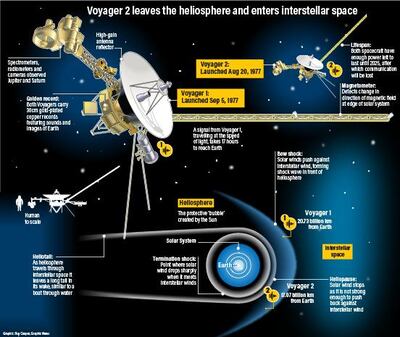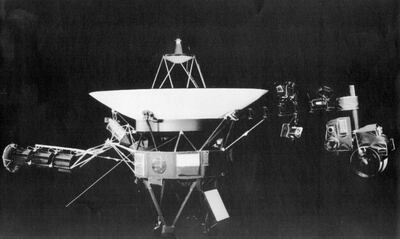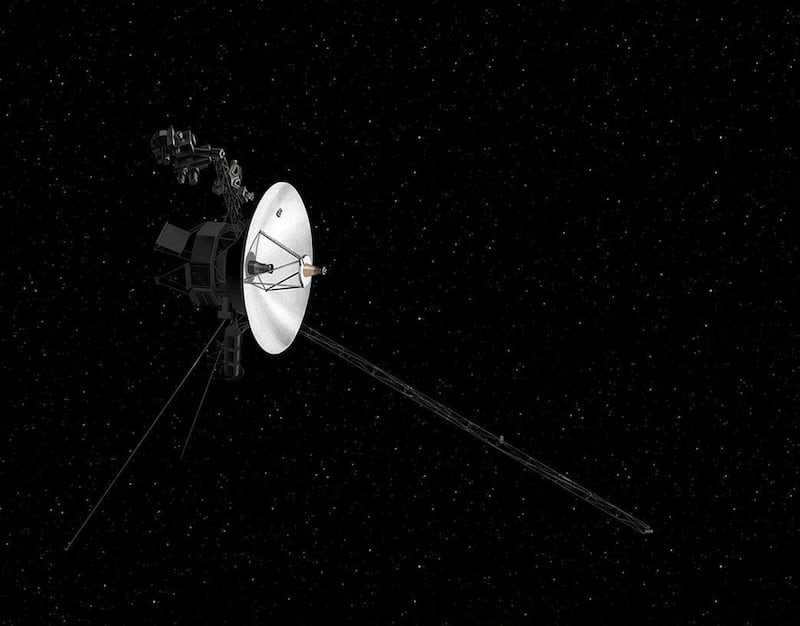What were you doing in 1977? For anyone under the age of 40, the answer is, waiting to be born.
This was the year that Elvis Presley died, Saturday Night Fever was released and everyone hoped that Anwar Sadat's historic first visit to Israel might lead to peace in the Middle East.
Kayne West was born in 1977, along with Shakira and Emmanuel Macron, president of France. And on August 21, at Cape Canaveral, the space probe Voyager 2 was launched.
Now Voyager 2 is entering interstellar space, beyond a protective bubble created by the Sun known as the heliosphere.
It is only the second man made object to do so, the other being its twin, Voyager 1, which confusingly was launched after Voyager 2, and which breached the heliosphere in 2012.

Both probes are part of what the American space agency called its "Grand Tour”, an opportunity to study the outer planets of our Solar System when they aligned in the late 1970s for the first time in over 170 years.
It was a 12 year mission, with the probe first reaching Jupiter in 1979, then slingshotting its way past Saturn two years later, Uranus in 1986 and finally Neptune in 1989.
It is the only spacecraft to have flown past both Uranus and Neptune.
That was not the end of it. Nasa's engineers had designed both Voyagers to keep going, and they have. Voyager 2 is currently estimated to be 18 billion kilometres from Earth, meaning it has travelled the equivalent of to the Sun and back 600 times.
The mission’s chief scientist, Dr Edward Stone, is 81, so was merely middle-aged when the probes were launched.
He confirmed at a conference in Washington that the Voyager 2 had entered interstellar space, probably in early November.
We know this, Dr Stone explained, because an instrument on the probe which measures particles from the Sun, also known as the Solar Wind, suddenly dipped.
Voyager 2 was now in "the space between the stars."
That space, known as the heliosphere, marks the end of the bubble of gases created by the Sun.
True deep space begins even further, past something called the Oort Cloud, believed to be the source of all comets. The Oort, whose existence is only theoretical, extends possibly 30 trillion kilometres from the Sun.
Sadly, neither of the Voyagers will be able to confirm its existence. Even with its current speed of 1.4 million kilometres a day, Voyager 2 will take 300 years to reach the speculated edge of the cloud and another 30,000 years to emerge on the other side.

Despite being powered by plutonium, the probe is predicted to run out of power by 2025, its instruments gradually shutting down one by one to conserve power.
Scientists hope it will continue to transmit valuable information back home until that date, taking about 19 hours to reach us. Because the probe’s recording system no longer functions, it sends back date continuously, for about 15 hours a day at a speed of 160 bits a second.
While internet speeds in the UAE are currently 5.7 megabits a second, or something like 35,000 times faster, it is still a considerable achievement given that the Apple launched its first computer in the year Voyager was launched.
Even when its instruments die, Voyager 2 will still carry a message. Like its twin, it was fitted with a gold-plated audio visual disc with recordings of life on Earth, including a baby crying, Chuck Berry singing Johnny B. Good, and a greeting from the president of the United States, then Jimmy Carter.
Like Voyager 2, President Carter, now 94, is still going strong. When, and if, aliens may hear his message is another matter.
Were its energy sources not so limited, it would be 40,000 years before the probe approaches the next star, and then at a distance of 1.7 light years. In 296,000 years, Voyager 2 will near Sirius, known as the Dog Star, also called Alhabor in Arabic, and the brightest star in the winter sky.
Whether peace on Earth will have been achieved by then is another matter.
________________
Read more:
We have lift-off: UAE's MYSAT-1 successfully launched
The inside story of how the UAE landed its first place in space







